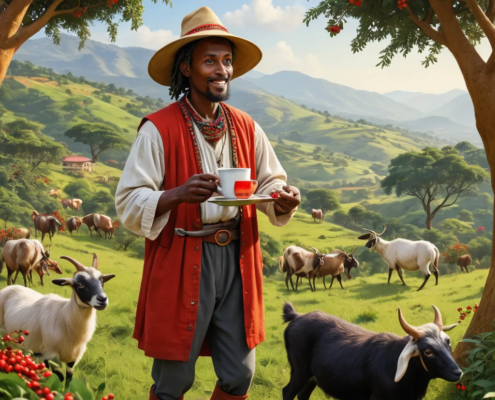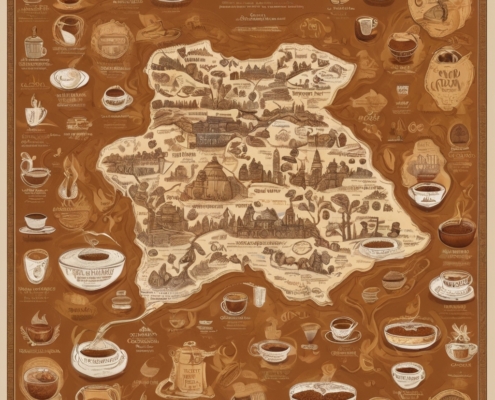The Tale of How Coffee magic Beans Were Discovered (Coffee Beans history)
Hey there, mug hugger and coffee lovers! Have you ever been curious about how that magical beans that gets you going was first discovered(Coffee Beans history)? Well, grab your favorite mug, fill it up with your favorite brew, and let’s dive into the fascinating journey of coffee’s origins!
Coffee Beans history – A Legend where everything starts.
Image this, It’s a sunny day in ancient Ethiopia, around the 9th century. A young man “goatherd” named Kaldi taking out with his goats for morning walk, probably bored wishing if can sleep longer this morning. Suddenly, he notices something weird. His goats are acting like they’ve just won the lottery – jumping, dancing, and bleating with more energy than a kid on a sugar rush!
Kaldi decides to find out what is going on with these crazy goats. He spots his goats munching on some bright red berries from the bush nearby. Now, I don’t know about you, but if I saw my pets eating strange berries and going bonkers, I’d probably think that my goats trying pull “La chevre de Mr sauga – the goat of Mr souga” against me. But not Kaldi! He decided to try whatever that red berry is, thinking, “Hey, if it’s good enough for my goats, its good enough for me!”
So, Kaldi tried a few red berries and– BAM! – he feels like he could out run an Ethiopian Cheetah. He’s so excited about his discovery that he grabs a bunch of these magical berries and rushes to the local monastery to show the monks.
Cautious bunch they are, the monks decide to throw the berries into the fire. But instead of just burning up, these red evil beans start to smell amazing! It’s like the world’s first coffee roast happening right there. The monks are so curious that they fish out the roasted beans, crush them up, and add mix them with hot water. And just like that, the world’s first cup of coffee is created!
Now, I know what your thinking – “Is this a real story?” Well, it’s probably about as real as an ECE teacher claim that they can go a whole day without coffee. In other words, it’s more of a fun legend tail than direct hard fact. But hey, it’s a great story, don’t you think?
Coffee Beans World Tour
After it’s legendary discovery in Ethiopia by our friends the goats, coffee decided to pack its bags and go on a world tour.
First stop: the Arabian Peninsula.
By the 15th century, the Yemini people smelled this great aroma coming from Ethiopia cross the red sea and so coffee had become the talk of the town in Yemen. The Yemeni people were like, “Hey, these beans are pretty magical! Let’s grow more!” And so, coffee cultivation of the coffee began. They even gave it a cool name: qahwa. a fancy name for a fancy bean, right? That’s where we get the word “coffee” from!
Coffee quickly became the center of the party in the Middle East. People started opening coffee houses, they called qahveh khaneh. These weren’t just places to grab a quick espresso to go. Oh no, they were like the ancient version of our modern hangout spots. picture a place back then where you could have some delicious coffee, listen to music, play games, and talk about everything and nothing at the same time. Sounds awesome, doesn’t it?
Here’s a fun little table to show you how coffee spread it’s wings:
| Year | Event |
| 9th | Kaldi discovers coffee in Ethiopia. |
| 15th | Coffee cultivation begins in Yemen. |
| 16th | Coffee spreads to Persia, Egypt, and Turkey. |
| 17th | Coffee houses (qahveh khaneh) open in the Middle East. |
| 18th | Coffee becomes popular in Europe. |
| 20th | Coffee is commercialized globally. |
Coffee Goes to Europe
By the 17th century, coffee was ready for its European adventure. It first showed up in Venice in 1615 “buongiorno italia”, the first coffee house was open in 1645 in Venice, oh boy, after that our magical beans did make a splash! At first, some people were scared of this new, dark drink. They called it the “bitter invention of Satan.” Talk about drama!
But coffee wasn’t about to let a few people stop it’s rise to fame. Soon enough, coffee houses started popping up in cities like Paris, London, and Amsterdam. In England, they called these places “penny universities” because for the price of a cup of coffee (which was a penny imagine that), you could sit and learn all sorts of things from the smart people hanging out there.
These coffee houses became the place to be if you wanted to sound smart. People would gather there to talk about books, science, and politics. It was like the internet of it’s time, but with better conversation and no Wi-Fi. The famous English writer Samuel Johnson even noted, “A cup of coffee is a cup of peace.”
The Espresso Express
As coffee’s become famous, people started getting creative with how they made it. In the late 19th century, some genius in Italy who got tired of spaghetti thought, “Hey, what if we force hot water through coffee really fast?” And just like that! The espresso machine was born.
This invention was like giving coffee superpowers. Suddenly, you could have a super strong, super tasty cup of coffee in no time flat. Espresso became the base for all those magical coffee drinks we enjoy today. Lattes, cappuccinos, macchiatos– they all start with a shot of espresso.
Here’s a quick guide to some popular espresso-based drinks:
| Drink | What’s in it? |
| Espresso | Just pure, concentrated coffee goodness |
| Latte | Espresso with steamed milk and a little foam on top |
| Cappuccino | Equal parts espresso, steamed milk, and milk foam. |
| Americano | Espresso with hot water (for when you want to pretend your drinking regular coffee) |
| Mocha Espresso | with steamed milk and chocolate (because sometimes you need a liquid candy bar) |
How Coffee Spread Around the World
The journey of coffee from the town of our Kaldi in Ethiopia to the rest of the world is full of interesting stories and characters.
Dutch Adventures: The Dutch played a primordial role in spreading coffee beans. They took coffee plants from Yemen to their colonies in Java (now Indonesia) and successfully cultivated them. From there, the magical seeds were taken back to the botanical gardens in Amsterdam and were cultivated in greenhouses.
French and Brazilian Contributions: Gabriel de Clieu a French naval officer smuggled a coffee seedling from King Louis XIV’s plant in Paris to Martinique in 1723. Despite a challenging voyage, he managed to transport it safely, which was the source of the wide spread of millions of coffee trees in the Caribbean and South America.
Brazilian Coffee: Brazil is the first country producing coffee now days but its existence is due Francisco de Mello Palheta, who was sent to French Guiana to get coffee seedlings. The French Governor’s wife, captivated by his charm, gave him a bouquet with coffee seeds hidden inside. This led to the beginning of Brazil’s massive coffee industry.
Coffee Beans history – Coffee Goes Global
Fast forward to today, and coffee is everywhere! It’s like the GOAT of beverages where everybody knows it, and most people love it. Coffee shops on every corner, thousands of coffee brands, and people are coming up with wild new ways to enjoy their coffee; thanks to Kaldi’s goats.
- Cold brew for those hot summer days.
- Nitro coffee for when you want your caffeine fix.
- Coffee cocktails for when you can’t decide between perking up or winding down.
Coffee it’s not just about the drink anymore. Coffee has become an entire culture. People hepsters out over different brewing methods, argue about the best roasts, and some folks even turn their noses up at anything that isn’t “artisanal” or “single origin.” (Don’t worry, we won’t judge you if you still love your instant coffee. Your secret’s safe with us!)
Coffee’s Impact on the World
Now, you might be thinking, “What it is all this about?!! It’s just a drink, right?” Wrong! Coffee has had a huge impact on the world. Let me count the ways:
It’s a social lubricant: How many times have you heard someone say, “Let’s grab a coffee”? It’s the perfect excuse to hang out with friends or even go on a first date. (Pro tip: If the date goes badly, at least you’ll be caffeinated enough to make a quick getaway!)
It fuels productivity: From writers to teachers to coders to students studying for exams, coffee has been the fuel behind countless innovations and good projects. Without coffee, who knows how many great ideas like this one would have been lost to the midday slump?
It sparked revolutions: No, really! Coffee houses in the 17th and 18th centuries were hotbeds of political discussion. Some rulers even tried to ban them because they were worried about people plotting revolutions over their lattes.
It’s a global industry: Coffee is one of the most valuable commodities in the world. Millions of people depend on coffee for their livelihoods, from farmers in Colombia to baristas in New York.
It’s inspired art and literature: How many poems, songs, and paintings have been created in cozy coffee shops? And let’s not forget about all those coffee-themed Instagram posts!
The Future of Coffee
So, what’s next for our beloved magical bean juice? Well, the future looks exciting!
Sustainability is becoming a real deal in the coffee world. People are starting to pay more attention to where their coffee comes from and how it’s grown. Fair trade and organic coffees are being supported by many people now days, and some coffee shops are even going zero-waste.
Technology is also changing how we enjoy our coffee. There are now smart coffee makers that you can control with your phone. (Because apparently, walking to the kitchen to press a button is just too much work these days.)
Scientists are even looking into the health benefits of coffee. Some studies suggest that coffee might help prevent certain diseases. So, the next time someone gives you the side-eye for your third cup of the day, just tell them you’re drinking it for your health!
Wrapping Coffee Beans history Up
From its humble starts as an unknow red berry that made some goats go crazy to its status as a global superstar, coffee has come a long way. It’s been a friend to tired students, a muse to artists, and a companion to many conversations.
So, the next time while you are drinking your favorite brew, take a moment to appreciate its journey to get to you. From those Ethiopian hills to your cup, coffee has traveled through time and across continents to give you that perfect morning boost.
And hey, if anyone ever tells you that you drink too much coffee, just remember: you’re not addicted, your just very, very loyal to Kaldi’s Goats, kidding, fill up your mug and enjoy Your Drink always!















